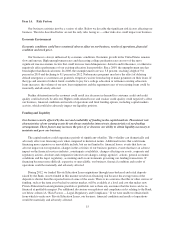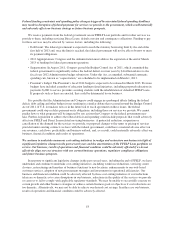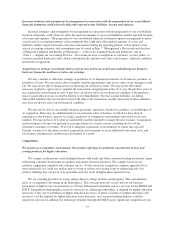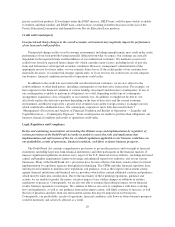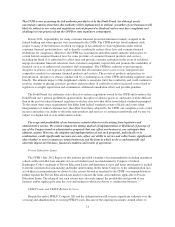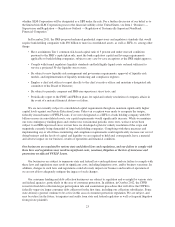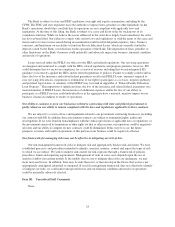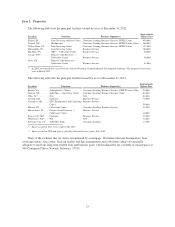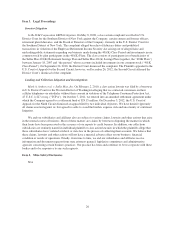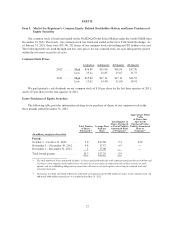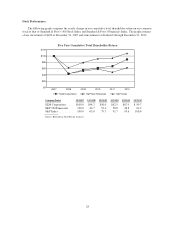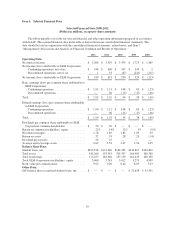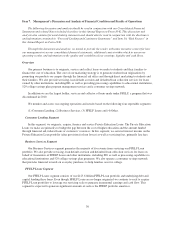Sallie Mae 2012 Annual Report Download - page 22
Download and view the complete annual report
Please find page 22 of the 2012 Sallie Mae annual report below. You can navigate through the pages in the report by either clicking on the pages listed below, or by using the keyword search tool below to find specific information within the annual report.private credit loan products. If loan limits under the DSLP increase, DSLP loans could be more widely available
to students and their families and DSLP loans could increase, resulting in further decreases in the size of the
Private Education Loan market and demand for our Private Education Loan products.
Credit and Counterparty
Unexpected and sharp changes in the overall economic environment may negatively impact the performance
of our loan and credit portfolios.
Unexpected changes in the overall economic environment, including unemployment, may result in the credit
performance of our loan portfolio being materially different from what we expect. Our earnings are critically
dependent on the expected future creditworthiness of our student loan customers. We maintain a reserve for
credit losses based on expected future charge-offs which considers many factors, including levels of past due
loans and forbearances and expected economic conditions. However, management’s determination of the
appropriate reserve level may under- or over-estimate future losses. If the credit quality of our customer base
materially decreases, if a market risk changes significantly, or if our reserves for credit losses are not adequate,
our business, financial condition and results of operations could suffer.
In addition to the credit risk associated with our education loan customers, we are also subject to the
creditworthiness of other third parties, including counterparties to our derivative transactions. For example, we
have exposure to the financial condition of various lending, investment and derivative counterparties. If any of
our counterparties is unable to perform its obligations, we could, depending on the type of counterparty
arrangement, experience a loss of liquidity or an economic loss. In addition, we might not be able to cost
effectively replace the derivative position depending on the type of derivative and the current economic
environment, and thus be exposed to a greater level of interest rate and/or foreign currency exchange rate risk
which could lead to additional losses. Our counterparty exposure is more fully discussed in Item 7
“Management’s Discussion and Analysis of Financial Condition and Results of Operations — Liquidity and
Capital Resources — Counterparty Exposure.” If our counterparties are unable to perform their obligations, our
business, financial condition and results of operations could suffer.
Legal, Regulatory and Compliance
Delays and continuing uncertainties surrounding the ultimate scope and implementation by regulators of
various provisions of the Dodd-Frank Act make us unable to assess the risks and implications that
implementation and enforcement of the law or related regulations applicable to our business could have on
our profitability, results of operations, financial condition, cash flows or future business prospects.
The Dodd-Frank Act contains comprehensive provisions to govern the practices and oversight of financial
institutions (including large non-bank financial institutions) and other participants in the financial markets. It
imposes significant regulations on almost every aspect of the U.S. financial services industry, including increased
capital and liquidity requirements, limits on leverage and enhanced supervisory authority, and on our various
businesses. Many of the Dodd-Frank Act’s provisions have become effective but many remain subject to formal
implementation by regulatory agencies through final rulemaking. The CFPB and other financial regulators have
introduced and continue to introduce new regulations and guidance, even as they impose enforcement actions
against financial institutions and financial service providers which often contain additional cautions and guidance
which must be taken into consideration. Due to the uncertainty of these pending regulations, guidance and
actions, we are unable to predict the nature, extent or impact of any further changes or additions to statutes,
regulations or practices. Consequently, we are also not able to estimate their ultimate impact on our financial
results, business operations or strategies. We continue to believe our costs of compliance with these evolving
laws and regulations, as well as any guidance from enforcement actions, will likely continue to increase, as will
the risk of penalties and fines from any enforcement actions that may be imposed on our businesses.
Consequently, our profitability, results of operations, financial condition, cash flows or future business prospects
could be materially and adversely affected as a result.
20







